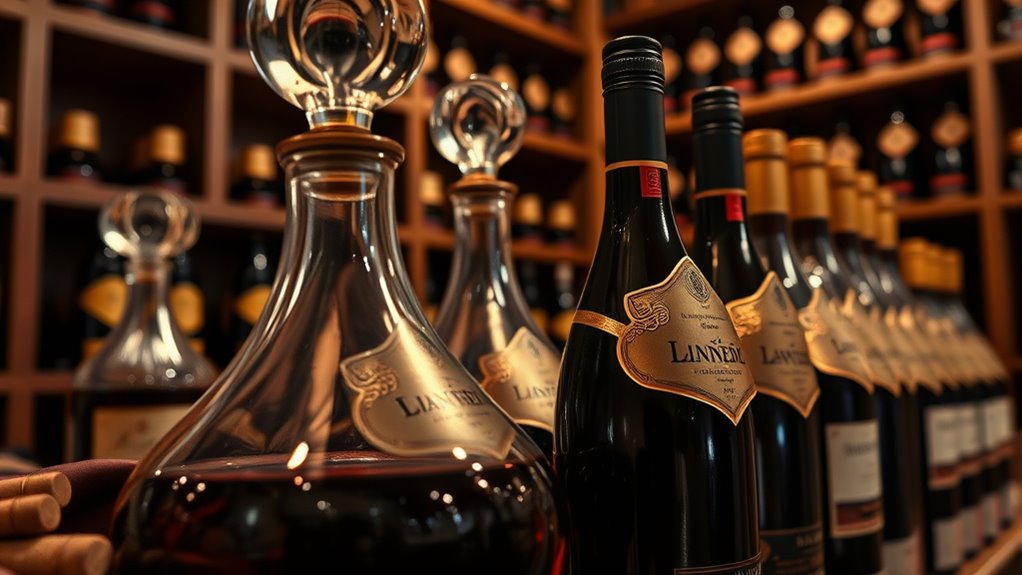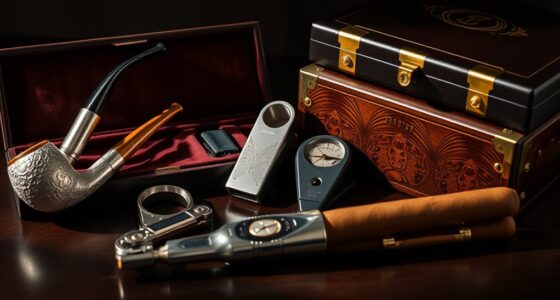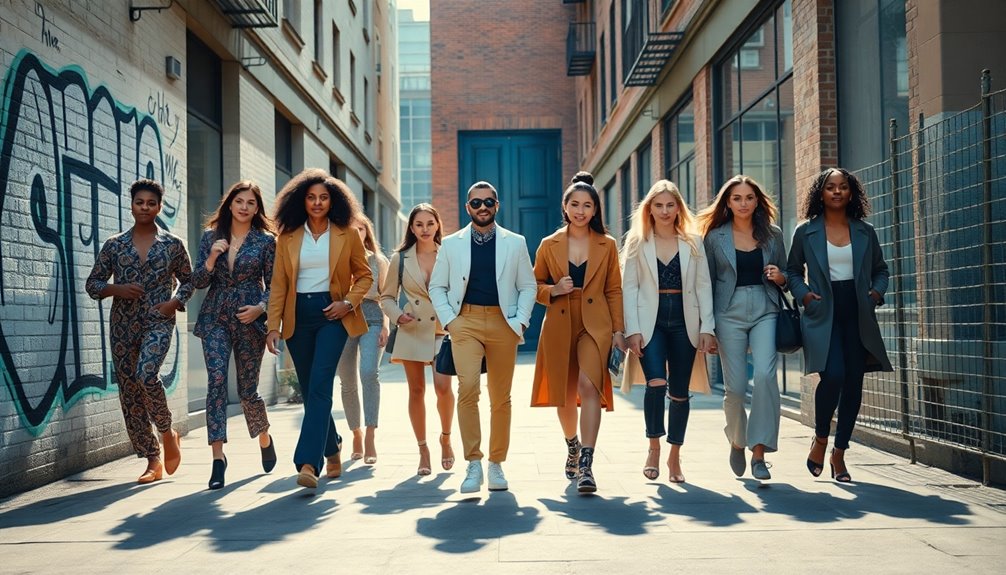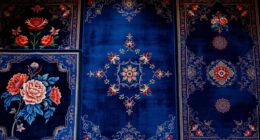The world’s most expensive wines come with compelling stories of rarity, history, and provenance that boost their value. Iconic bottles like Château Lafite 1787 and Domaine de la Romanée-Conti 1945 fetched record prices, driven by limited production, unique features, and legendary origins. Provenance and authenticity play essential roles, with scientific methods helping verify their history. To discover how these stories shape their legendary status, you’ll find fascinating details if you continue exploring.
Key Takeaways
- Iconic wines like Château Lafite 1787 and Domaine de la Romanée-Conti 1945 have fetched record-breaking auction prices due to rarity and storied provenance.
- Provenance verification, often through scientific testing, is crucial but challenging, impacting the perceived authenticity and value of historic wines.
- Limited production runs and unique bottling features, such as ampoules and special editions, significantly enhance a wine’s exclusivity and market worth.
- The story behind each bottle—including historical figures, events, and vintage significance—adds legendary status and desirability.
- Market trends, collector demand, and auction records continually elevate the prices of the world’s most expensive and storied wines.
Legendary Bottles With Historic Price Tags
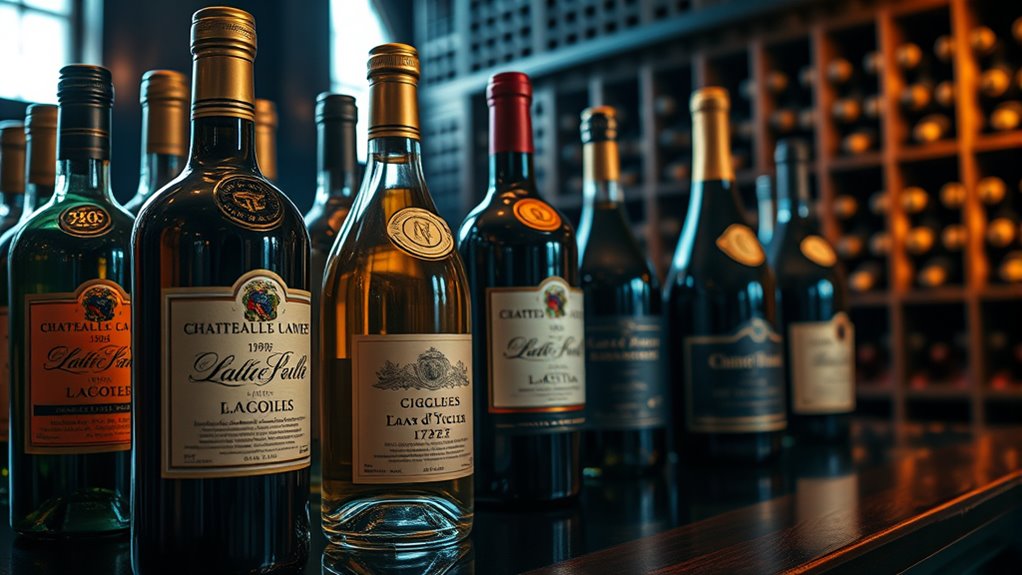
Some of the most legendary wines are defined not just by their exceptional quality but also by their historic price tags. Take Chateau Lafite, for example, with its vintage bottles fetching astonishing sums at auction. The 1787 Chateau Lafite, believed to belong to Thomas Jefferson, sold for $156,450 in 1985, highlighting its rarity and historical significance. Similarly, a 1787 Château Lafite Rothschild recovered from a Paris cellar was valued at $225,000 before it shattered. These auction records underscore how certain vintages become legendary, not just for their taste but for their stories and provenance. Whether it’s the historic Jefferson connection or the rarity of the vintage, these wines command prices that make them true icons in the world of collectible wine. The value of collectible wines can fluctuate based on market trends, rarity, and provenance, making them a fascinating investment for connoisseurs and collectors alike. Additionally, understanding the market trends helps collectors anticipate changes in a wine’s value over time. Furthermore, factors like aging potential can significantly influence a wine’s long-term worth.
The Mysteries Behind Jefferson’s Fabled Lafite
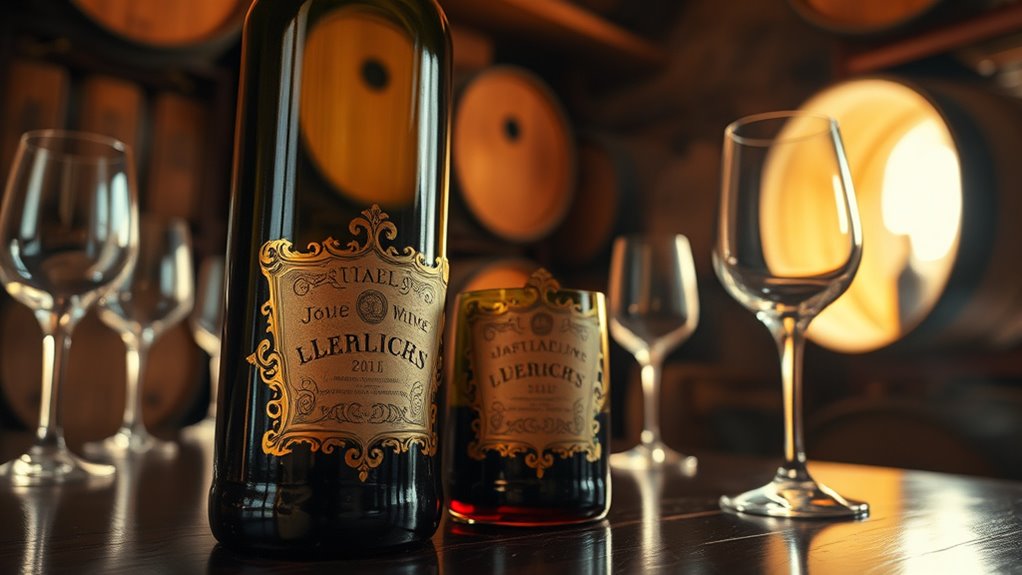
You might wonder if Jefferson’s Lafite bottles are truly authentic or just clever forgeries. Experts debate their provenance, with some questioning whether they genuinely belonged to Thomas Jefferson. The ongoing controversies keep the mystery alive, fueling both curiosity and their high market value. Implementing targeted campaigns to reach collectors and enthusiasts can further influence their valuation and public perception. Additionally, authenticity verification methods are continually evolving to better determine the provenance of such rare wines, adding complexity to the debate. Recent advancements in forensic analysis are increasingly used to authenticate historic wine bottles, though challenges remain in applying these techniques to ancient specimens. As research progresses, the potential for more precise detection methods offers hope for resolving many of these uncertainties.
Authenticity Controversies Persist
The authenticity of Thomas Jefferson’s purported 1787 Château Lafite bottles remains a hotly debated issue, with experts questioning whether they are genuine artifacts or elaborate fakes. Provenance is at the heart of the controversy, as conflicting evidence makes it hard to confirm their true origin. Some analytical tests suggest authenticity, while others raise doubts, fueling suspicion about whether these bottles are legitimate or counterfeit. The widespread presence of fakes in the Jefferson wine market, highlighted by Bill Koch’s lawsuit against Hardy Rodenstock, underscores the risks of misidentification. Despite questions over provenance, these bottles continue to fetch high auction prices, driven by their legendary status. This ongoing controversy exemplifies the difficulty in verifying historic wine authenticity, which impacts valuation and collector confidence markedly. Cybersecurity vulnerabilities associated with digital records and authentication processes further complicate efforts to establish trust in such rare collectibles. Additionally, efforts to verify such artifacts often rely on authentication techniques, which can vary in accuracy and reliability. The challenge of traceability in the wine industry is a significant factor in these ongoing disputes. Furthermore, the integration of creative practice principles into authentication processes could potentially enhance the accuracy and reliability of verifying rare wines.
Historical Provenance Debates
The debate over the authenticity of Thomas Jefferson’s purported 1787 Lafite Rothschild bottles has captivated collectors and historians alike, turning them into symbols of mystery and prestige. Central to this debate is the provenance of these rare wines, which remains uncertain and contested. Some experts question whether the bottles are genuine or counterfeit, citing inconsistent provenance and expert doubts. In 1985, a bottle believed to be Jefferson’s Lafite sold for $156,450, fueling speculation about its authenticity and historical significance. The controversy was further fueled by Bill Koch’s lawsuit, claiming the bottles were forgeries as part of a larger counterfeit wine scheme. Despite ongoing debates, Jefferson’s connection to the 1787 Lafite has cemented its legendary status, making it one of history’s most mystified wines. Understanding provenance is crucial in evaluating the authenticity of such rare collectibles. Additionally, advancements in scientific testing help authenticate and preserve the integrity of these valuable artifacts for future generations. The role of historical documentation in verifying provenance remains a vital part of this ongoing investigation.
Iconic Wines From Bordeaux and Burgundy
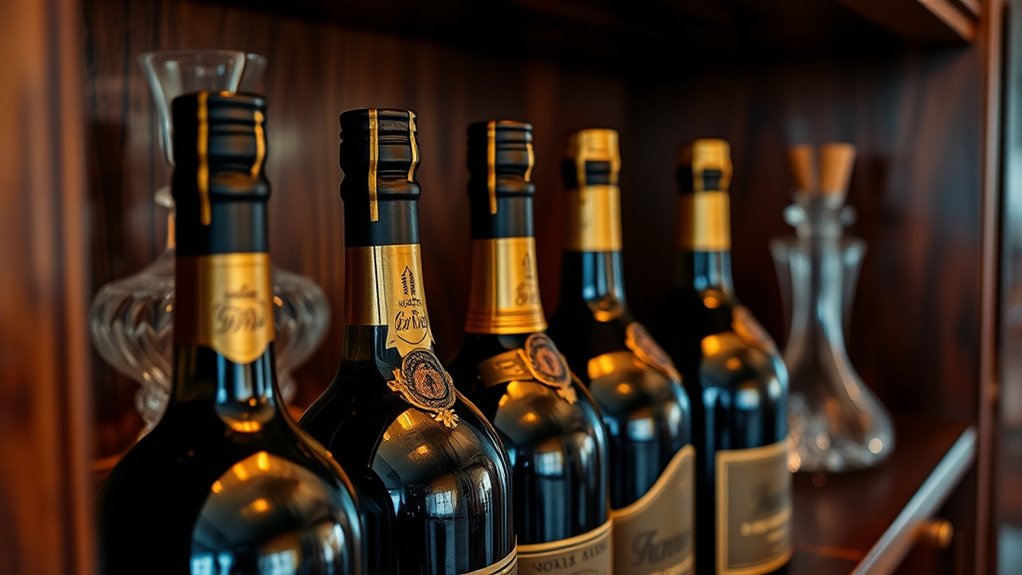
Iconic wines from Bordeaux and Burgundy have garnered worldwide fame for their exceptional quality, rarity, and historical significance. Bordeaux’s Château Lafite, especially the 1869 vintage, and Château Margaux from 1787, are legendary for their record-breaking auction prices, often exceeding $200,000 per bottle. Burgundy’s Domaine de la Romanée-Conti produces some of the world’s most expensive Pinot Noir and Chardonnay vintages, with bottles like the Romanée-Conti 1945 selling for over half a million dollars. These wines are prized for their limited production, often only a few hundred bottles per vintage, which drives their high market value. Surviving centuries, many are linked to historical figures and events, boosting their prestige and desirability among collectors and investors worldwide.
Exceptional Vintage Sales and Their Significance
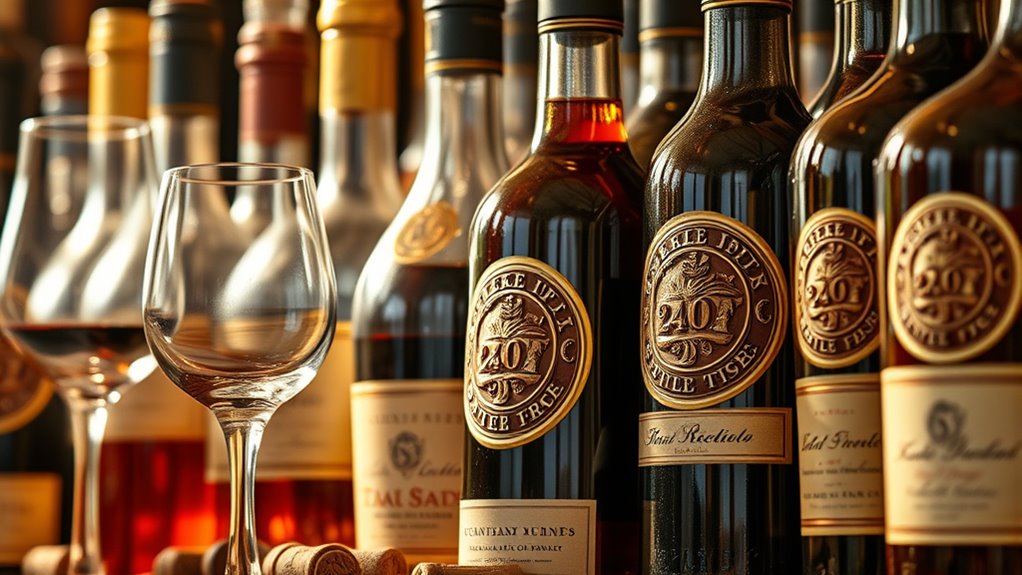
Exceptional vintage wine sales often set record prices that reflect more than just their taste; they embody rarity, historical importance, and prestige. When you see record-breaking sales like the Domaine de la Romanée-Conti 1945 fetching $558,000, it’s clear that provenance plays a pivotal role. These sales aren’t just about the wine itself but also about the story, age, and unique origin behind each bottle. The Jeroboam of Château Mouton-Rothschild 1945, sold for over $310,000, highlights how exceptional vintages from significant periods command extraordinary value. Even the Château Margaux 1787, linked to Thomas Jefferson, underscores the importance of provenance in elevating a vintage wine’s status. These sales exemplify how scarcity and historical context drive prices beyond mere taste, creating legendary status for collectors worldwide. Additionally, the age of the wine can significantly influence its value, as older vintages often carry greater rarity and allure, with the vintage year itself becoming a key factor in valuation.
The Rarity of Limited Edition and Rare Bottlings
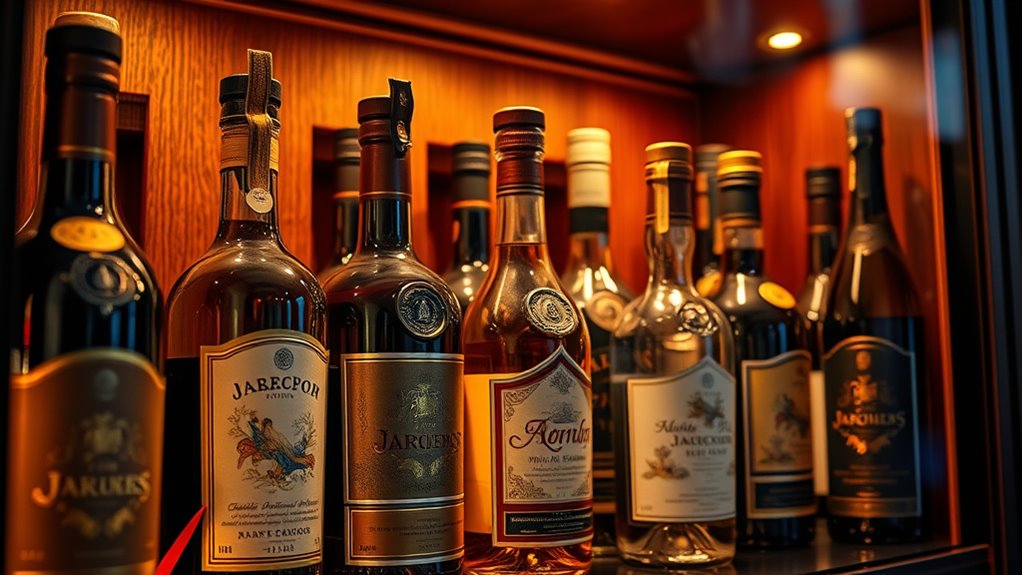
Limited edition wines with tiny production runs or unique bottling features are what make them highly desirable. Their scarcity drives up prices and attracts collectors enthusiastic to own something truly rare. These factors turn such bottles into some of the most sought-after and expensive wines in the world. Additionally, the vintage quality and the reputation of the winery further contribute to their exclusivity and value. The rarity and limited availability of these wines also mean that provenance and authenticity are carefully scrutinized by connoisseurs. Incorporating natural elements such as specific terroirs or unique vineyard conditions can further enhance their allure and perceived worth.
Limited Production Runs
Many of the world’s priciest wines come from limited production runs, where fewer than 1,000 bottles are often made each year. This scarcity considerably boosts their rarity and desirability among collectors. Limited runs like Château Lafite 1869 or Domaine de la Romanée-Conti 1945 are produced in tiny quantities, sometimes only a few hundred bottles. Special editions such as Penfolds Ampoule (12 bottles) or Château Cheval Blanc 1947 (16 bottles) exemplify the exclusivity that limited production fosters. The rarity of these bottles often drives their value sky-high at auction, sometimes far exceeding their original price. You’ll find that these limited runs are carefully curated to highlight exceptional terroirs, vintages, or winemaking philosophies, elevating their market appeal and status. Additionally, many of these limited-edition wines are created with a focus on unique terroirs, which further enhances their exclusivity and appeal to connoisseurs. In some cases, these wines are also leveraged for branding, making them highly sought after by collectors and investors alike. The craftsmanship behind their production ensures that each bottle is a masterpiece, adding to their collectible appeal.
Unique Bottling Features
Unique bottling features markedly enhance the rarity and allure of some of the world’s most expensive wines. For example, limited edition wines like the Penfolds Ampoule come in glass ampoules that must be be broken to open, emphasizing their exclusivity. Rare bottles such as the 1775 Massandra Sherry are preserved as part of historic collections, often with only one bottle existing worldwide. Ultra-rare wines like the 1945 Château Mouton-Rothschild Jeroboam are produced in tiny quantities and fetch top dollar at auctions. Some bottles, believed to be linked to Thomas Jefferson, are relics with disputed authenticity, adding mystique. These unique features, whether a sealed ampoule or a rare vintage, make these wines not only precious but also a testament to craftsmanship and rarity.
| Bottling Feature | Description |
|---|---|
| Ampoule | Glass container requiring breaking to open |
| Limited Edition | Small batch production, often exclusive |
| Rare Bottles | Unique, often historic, with few or single bottles |
The Role of Provenance and Authenticity in Valuation
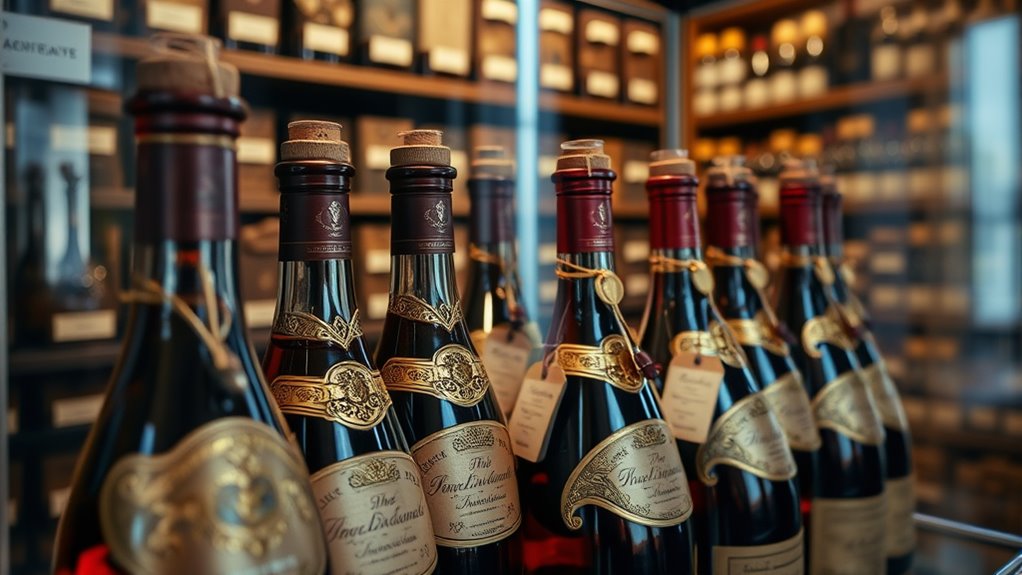
Provenance and authenticity are vital factors that directly impact a wine’s market value, especially among collectors and investors. When a bottle’s history is well-documented and verified, it commands higher prices at auction. Conversely, doubts about authenticity, such as counterfeit Jefferson bottles or disputed vintages, can sharply reduce a wine’s worth. Provenance includes ownership records, auction histories, and scientific authentication, all of which establish legitimacy. For example:
- Rare wines with verified provenance fetch record-breaking prices
- Scientific analysis confirms authenticity of ancient bottles
- Well-documented history boosts collector confidence
- Counterfeit issues lower market value
- Provenance verification is essential during auction bidding
The Impact of Market Trends on High-End Wine Prices
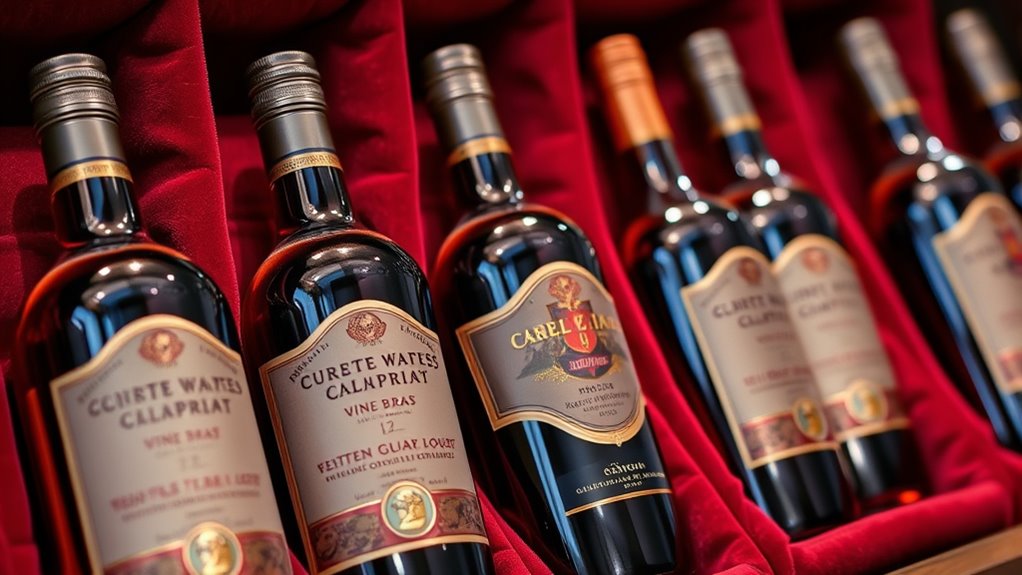
Market trends play a pivotal role in shaping the prices of high-end wines, with factors like collector demand and rarity driving fluctuations in value. Auction sales often set new records, reflecting shifting valuation standards influenced by market dynamics. Provenance and vintage quality heavily impact prices, as wines with documented history and limited production command premiums driven by current interest. The emergence of new wine regions and cult wines has further pushed prices upward, fueled by increasing global demand and scarcity. Market speculation and future sale expectations create a feedback loop, escalating prices as collectors seek exclusivity and prestige.
| Market Trend | Impact on Pricing | Emotional Appeal |
|---|---|---|
| Collector Demand | Raises prices | The thrill of owning rare treasures |
| Rarity & Provenance | Adds value | Confidence in authenticity |
| Auction Sales | Sets benchmarks | The excitement of record-breaking sales |
| New Regions & Cult Wines | Boosts scarcity | The allure of exclusivity |
| Market Speculation | Fuels growth | The chase for future investment |
Frequently Asked Questions
What Is the No 1 Most Expensive Wine in the World?
You’re curious about the most expensive wine in the world. It’s the 1945 Domaine de la Romanée-Conti Grand Cru, which sold for $558,000 at auction in 2018. Only 600 bottles exist, making it incredibly rare. Its age, history, and reputation among collectors drive its value sky-high. For luxury wine collectors, this vintage represents the ultimate blend of rarity, prestige, and investment potential.
How Much Is a 300 Year Old Bottle of Wine?
You might think a 300-year-old bottle of wine costs a fortune, and you’d be right—sometimes over $100,000. Yet, it’s not just age that inflates its price; provenance, rarity, and condition matter just as much. You’ll need to verify authenticity, or risk buying a fake. Ironically, while the bottle’s age suggests priceless history, the true value lies in its story—and whether you can prove it’s genuine.
What Is the Most Expensive Wine History?
You’re curious about the most expensive wine in history. It’s the Domaine de la Romanée-Conti Grand Cru 1945, which sold for $558,000 at Sotheby’s in 2018. Its rarity, age, and historical significance drive its high value. You can’t overlook legendary bottles like the Château Lafite 1787 or the 1775 Massandra Sherry, each telling unique stories of preservation, provenance, and exceptional vintages that make them priceless treasures in wine history.
What Is the Most Expensive Wine in the USA?
Imagine you’re at a charity auction and see a six-liter bottle of 1992 Screaming Eagle Cabernet Sauvignon. You’d learn it’s the most expensive wine sold in the US, fetching $500,000. Its rarity, high demand, and perfect score drive its value. This example shows how limited supply and prestige can push wine prices sky-high, making it a symbol of luxury and collector interest in America.
Conclusion
As you explore these legendary wines, remember they’re more than just liquid treasures—they’re symbols of history, passion, and rarity. Each bottle whispers stories of craftsmanship and time, reminding you that true value lies in the journey, not just the price. When you seek the world’s most expensive wines, you’re embracing a legacy that forever connects us to the soul of winemaking. In their silence, they speak volumes—an eternal toast to excellence.
